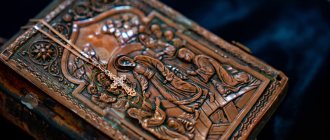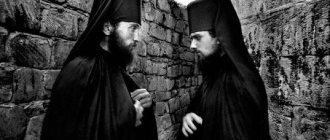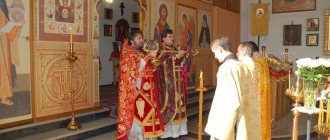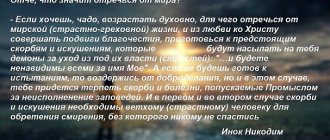After seventy years of persecution of the church in our country, not only churches, but also monasteries began to be revived. More and more people are turning to faith as the only means of finding peace of mind. And some of them choose spiritual achievement and monasticism, preferring the monastery cell to the bustle of life. In the ordinary understanding, a monk is a monk, a hermit, a monk. But in the Orthodox tradition, this is a person who only accepts monasticism. He is dressed like a monk, but can live outside the walls of the monastery and has not yet taken the monastic vow.
Degrees in Orthodox monasticism
Monks and nuns go through a number of stages throughout their lives—degrees of monasticism. Those who have not yet finally chosen the path of monasticism, but live and work in the monastery, are called laborers or laborers. A laborer who has received a blessing to wear a cassock and a scufa and has decided to remain in the monastery forever is called a novice. A cassock novice becomes one who has received the blessing to wear monastic clothes - a cassock, hood, kamilavka and rosary.
Then the ryassophore novice, who has made a firm decision to become a monk, takes monastic tonsure as a ryassophore. A monk is a monk who has undergone the ritual of symbolically cutting his hair and has been given a new name in honor of his heavenly patron. The next stage is the adoption of the small schema or small angelic image. At the same time, the monk undergoes the rite of monastic or mantle tonsure, takes vows of renunciation of the world and obedience, changing the name of the heavenly patron and blessing of monastic robes. The final rite of acceptance of the great angelic image or great schema includes the repetition of the same vows, a symbolic cutting of the hair, and another change in the name of the heavenly patron.
Degrees of monasticism
When a sister first enters a monastery, she is a candidate for novices , i.e. is being tested. She gets acquainted with monastery life and tries her hand. The abbess and her sisters see whether she has a sincere will to become a monk, whether she wants to serve the one Lord with all her heart, or whether she just wants to hide in the monastery from everyday worries and sorrows, to receive only “shelter and care.” The time of such a test is determined by the abbess of the monastery.
After the probationary period, when the applicant fully learns all the customs of the monastery, is convinced that she is able to follow them, and continues to express a desire to join the monastery, she is enrolled as a novice . For this purpose, a petition is written in the name of Mother Abbess and an autobiography. After this, the sister puts on a cassock and officially becomes a nun of the monastery.
The next step is tonsure into the ryassophore, or monasticism . One who is tonsured into the ryassophore is called a nun. Usually during this tonsure the name is changed to mark the beginning of a new life. According to the immutable commandment of the Savior: “Ask, and it will be given to you” (Luke 11:9), the newly tonsured woman is given a special grace that promotes her salvation, and a new intercessor is also given - a saint, whose name she receives at the time of tonsure.
In the proper sense, monasticism begins with tonsure into the small schema, the mantle. “A great thing is tonsure into a holy angelic image. Great and mysterious is the power contained in his sacrament, directed towards a person becoming an angel in the image of his inner life, for angels are incorporeal,” said the spiritual daughter of the holy righteous John of Kronstadt, the founder of eight women’s monasteries, Abbess Taisiya (Solopova).
To be tonsured is like a second baptism, in which a person is again reborn and renewed. As a sign of this new birth, he forever strips off his worldly clothes, and before the Holy Gospel, as if from the hand of God Himself, he accepts new clothes. The Great Optina Elder Macarius wrote in his letters:
“What a great gift of God to belong to the number of companions of Christ, to walk the narrow path that our Savior and God walked, to bear part of the cross, which for my salvation was completely lifted up and sacrificed to the justice of God by the Lord Jesus! What happiness for the sake of Christ Jesus, with devotion to Him: either to suffer the loss of external goods - property, honor, or to endure illness in the body or sorrow in the soul! Devotees of sensuality, living only an external life, do not know this happiness; If you tell them about this gift of God’s goodness, they will not understand you...”
A nun who has spent considerable time in spiritual life, who has excelled in monastic virtues, and most importantly, who has loved prayer with all her soul and acquired the skill of staying in it for a long time, who has become capable of offering heartfelt prayers not only for herself, but also for her neighbors, can be tonsured into the great schema . called the great angelic image. Following the great angelic image is very similar to following tonsure as a monk, because in essence, during this rite the vows already given are only repeated, but this rite is performed with even greater solemnity. The monastic nun also receives her own special clothes, which the manate nun does not have: a great paraman and a kukol with analava, she can again be given a new name - as a sign of the beginning of a new life, in comparison even with the previous monastic one.
This is the external side of the monastic path, however, “if internal work according to God does not help a person, then in vain he works externally,” says the Venerable Barsanuphius the Great. The essence of monasticism is an internal complete and inextricable union with the Lord through mental prayer and repentance. Anyone who is not like this and does not strive for this is not a monk, according to the holy fathers.
The Monk Barsanuphius of Optina said to his novice Nikolai, the future Elder Nikon of Optina:
“Not all monasticism consists of a cassock and porridge. He put on his cassock, began to eat porridge and thought: I have now become a monk. No. The external alone will not bring any benefit. True, you need to wear monastic clothes and fast, but that’s not all. A lamp, until it is lit, does not justify its purpose - to shine. What is missing? - Ogonyok. Both wick and kerosene are needed, but if there is no fire, if it is not lit, it does no good to anyone. When it is lit, light will immediately flow. It’s the same in monasticism: appearance alone does not bring any benefit; an inner flame is needed. Father Anatoly said that “monasticism is the hidden person of the heart.”
Monasticism as a degree of monasticism
“Monk” is a word that was formed from the Old Russian “in”, which means “alone, lonely, hermit.” This is what Chernets monks were called in Rus'. Currently, in Orthodox monasteries, monks are not called monks who have already accepted the small or great schema, but monks - those who wear a cassock, those who are just awaiting tonsure, the final acceptance of all vows and the naming of a new name. Thus, here a monk is like a beginning monk, and monasticism is a preparatory stage before the tonsure of the mantle. According to the canons of the Orthodox Church, tonsure as a monk can only be done with the blessing of the bishop. In women's monasteries, many nuns spend their entire lives in this monastic degree, without accepting further ones.
Monk's vow
A person who takes monasticism makes special vows - obligations before God to fulfill and observe the Law of God, church canons and monastic rules for life. After passing the tests - temptations - the degrees of monasticism begin. They differ not only in monastic robes and different rules of behavior, but also in the number of vows that are given before God.
The three main ones that are given by ryassophore novices upon entering the monastic degree are the vows of obedience, non-covetousness and chastity.
The basis of monasticism, the great virtue, is obedience. A monk is obliged to renounce his thoughts and will and act only according to the instructions of his spiritual father. The vow of non-covetousness is an obligation to live according to God's commandments, endure all the difficulties of monastic life, and also renounce all earthly goods. Chastity, as the fullness of wisdom, represents not only the overcoming of carnal desires, but also spiritual perfection, their achievement, constant abiding of the mind and heart in God. The soul must be chaste for the sake of pure prayer and continuous abiding in Divine love.
A person who has embarked on the path of monasticism must renounce everything worldly in order to develop the power of spiritual life and fulfill the will of his mentors. Renunciation of the old name, renunciation of property, voluntary martyrdom, life in hardship and hard work far from the world - all these indispensable conditions must be met by the monk for the further acceptance of angelic images.
Conversation with sisters about monastic and monastic tonsure
Abbess Ksenia (Chernega)
On October 8, on the day of remembrance of St. Sergius of Radonezh, abbot of the Russian land, Mother Xenia held a conversation with the sisters of the monastery about monastic and monastic tonsure, based on the presentation of these issues in the draft “Regulations on Monasteries and Monastics.”
Who are monks, what does it mean to be tonsured into the minor schema, what are the similarities and differences between the internal structure of a nun who has risen to the first stage of monasticism and a robed nun who has made irrevocable promises before the Lord, Mother and her sisters examined.
In the Russian Orthodox Church, the first degree, the first stage of monasticism is monastic tonsure. Monasticism, otherwise the cassock, (literally from Greek - wearing a cassock). Monastic tonsure is performed on novices who have lived in the monastery for at least three years, as established in the “Regulations on Monasteries and Monastics.”
The next step is mantle tonsure (minor schema). Those tonsured into the minor schema take vows of obedience, non-covetousness and chastity, renounce the world, and also promise to remain in the monastery in fasting until their last breath, observe the monastic rules, and endure all the sorrows of the “Kingdom of Heaven.”
Nun and robed nun. What are the differences? What's in common?
External differences - in clothing - are, of course, of a secondary nature. The vestments of the nun, the mantle, as well as the paraman, which is invisible to the prying eye, are absent from the nun’s vestments.
Essentially, monastic tonsure differs from monastic vows.
The nun, although she does not yet make these three promises - obedience, non-covetousness and chastity, she cannot take off her vestments and enter into marriage, cannot afford to leave the monastery, that is, in fact, without making these vows, she, nevertheless , lives under these vows. She has not yet pronounced them publicly, but she is already burdened with them, essentially because in the ryasophore tonsure some of the beginnings of these vows already sound - this is an irrevocable stay in the monastery, a transition from worldly life, from worldly vanity. These promises are heard in prayers during tonsure into the ryasophore, though not from the lips of the one being tonsured, but from the lips of the one who is tonsuring her: “We give thanks to You, O Lord our God, Who in Your many mercy has delivered Your servant from the vain worldly life, and You have called upon her for this honest promise, make me worthy to live worthily in this angelic life.”
That is, it is already clear - the prayers for tonsure speak about the angelic life of the newly tonsured woman and that she was taken out of the world, the Lord delivered her “from a vain worldly life,” and if he delivered her, then returning to this life is already a sin before God and is unacceptable for the nun. And such a step for a nun, unlike a novice, cannot go unpunished.
As we see, the rite of monastic tonsure can be considered as a certain obligation that the newly tonsured woman takes upon herself, the obligation to “remain irrevocably in the monasteries in fasting and prayer,” which the future nun testifies to in the conversation with the abbess of the monastery that precedes tonsure.
Monastic tonsure, performed with hair cutting and a change of name, also gives grounds to classify the ryassophores as monastics. “By taking away and cutting the hair, [the one being tonsured] brings to the Lord, as a sacrifice, the firstfruits of the body: for he offers and devotes himself entirely to Christ, and has rejected everything unnecessary and worldly” (Blessed Simeon of Thessalonica).
Further in the conversation, Mother focused on examining the internal, spiritual structure of a nun at the initial stage of monasticism and a nun tonsured into the mantle.
The sisters shared their understanding of this issue, talked about the monastic prayer rule, about spiritual qualities, that thanks to growing experience, a nun comes to the realization of her own insignificance, to humility, that is, that the spiritual experience of a nun exceeds the internal skill of a nun, taking the first steps in monastic life.
Mother noted that indeed, one can agree that a nun should be more skilled in spiritual work; she has a certain baggage of spiritual work behind her.
This is confirmed by the fact that in monasteries people are usually tonsured sequentially - first into the ryassophore, and then into the mantle. Mantle tonsure is now permitted only upon reaching the age of 30.
Sometimes it happens, as happened in our reviving monastery - the first sisters immediately took monastic vows. But this is possible due to the fact that the monastery had just been created.
A nun differs from a nun not only in spiritual experience and skill. Mother shared her vision of this issue with the sisters.
I myself have walked this path from monasticism to monasticism, and I can say that the nun has some perspective. If joining the monastic rank was a conscious step, then such a nun cannot help but think about monasticism; for her this goal is a primary and all-consuming one. She weighs every deed, every action of hers, in proportion to her upcoming monasticism.
The nun is at the stage of preparation for taking monastic vows. And this period of apprenticeship, the period of preparation for a certain event, is invariably present in the life of every nun. Having committed some unseemly act, she asks herself the question - “what kind of nun will I be, am I ready for monasticism, am I ready to be tonsured into a mantle?” I reproached myself all the time and recognized myself as unfit for monastic life.
A nun realizes more deeply than a nun the responsibility that lies on her, she experiences her fall, her sin more deeply, because she already bears the burden of vows. All the nun’s sins are a violation of the vows given to the Lord, and therefore her experiences are much deeper and much more difficult than the experiences of the nun.
Monasticism is actually a very big responsibility and it is a pity that, often, we do not understand this and drive away such thoughts from ourselves. A nun must take very careful care of herself, realizing that her sins are already a violation of the promises that she publicly made to God.
Spiritual warfare among nuns is already a struggle not for life, but for death. That is why the holy fathers determined the need for a period of preparation, because monasticism is bloodless martyrdom. Of course, one must prepare for this martyrdom; the monastic title without proper preparation can not only crush, but also cripple. A nun is already a Christian who has entered into mortal combat with the enemy of the human race. Even our monastic clothing symbolizes weapons, and nuns are more protected than nuns because their warfare is heavier.
Mother promised to talk about monastic armor in one of the following conversations.
December 19, 2017
Social media
Short link:
copied









